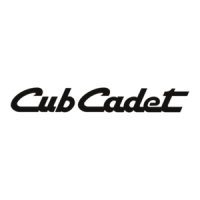BACKFILLING
Approach the pile with a flat bucket. See Figure 20.
Poor methods actually move no more dirt and make
it more difficult to hold a level grade.
Figure
20
Do not use the bucket
in
the dumped position for
bulldozing. This method, shown below, will impose
severe shock loadings on the dump linkage, the
bucket cylinder, and the tractor. See Figure
21
.
Leave dirt
in
the bucket because dumping on each
pass wastes time.
Operate at right angles to the ditch. Take as big a bite
as the tractor can handle without lugging down.
Leave dirt which drifts
over
the side of
the
bucket for
final clean-up.
Pile dirt on the high side for easier backfilling
on
a
slope.
NOT
THIS
Figure
21
BACKBLADING
Position the bucket at an angle of less than 45 ° and
backup slowly. See Rgure 22.
F-8297 (1-94)
9
Figure
22
I
Backblading with bucket tilted too far may result
in
damage to tilt cylinders and ¥oid warranty. See
Figure 23. I
Figure
23
i
i
HANDLING LARGE HEA'lY OBJECTS
AwARN~NG
■
The model 416 and
41~
loaders are not
equipped with any met~od to prevent
objects such as round bales, posts, logs,
etc. from rolling back ont~ the operator.
•
Do
not carry posts. I logs, round hay
bales, and other simil~r large objects
that can
fall
out of loa~er bucket.
• Serious injury
or
d~ath can result
if
objects fall from
buckf
t.
■
Always protect yours~lf
by:
I
• Never lifting the lo~der higher than
necessary
to
clear tije ground when
• I
movmg.
1
• Ballasting the trac~or rear
to
com-
pensate for the load. I
• Never lifting large objects with
equipment that does
pot
have an anti-
rollback device. ·

